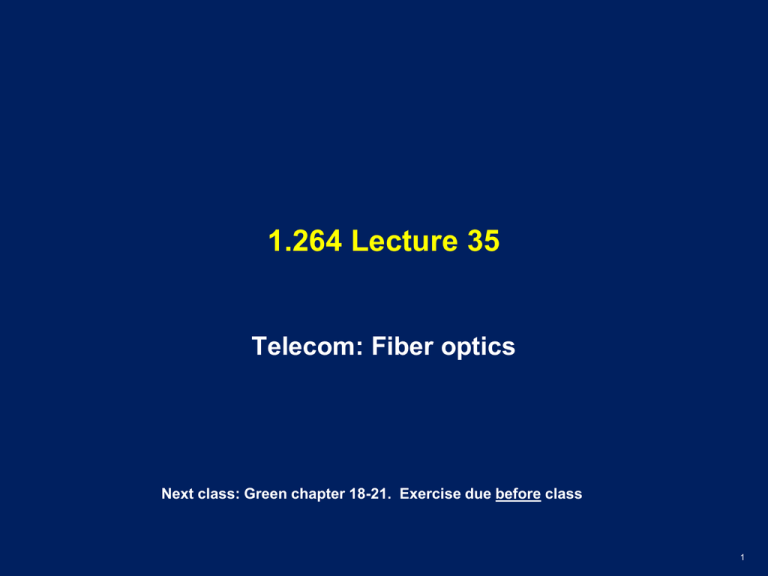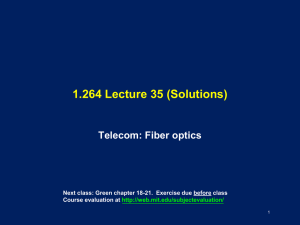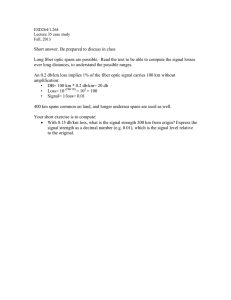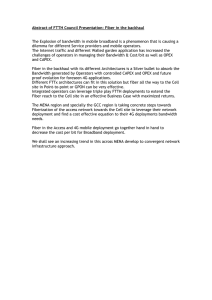
1.264 Lecture 35
Telecom: Fiber optics
Next class: Green chapter 18-21. Exercise due before class
1
T1
• T1 is shorthand for 1.5 Mbps connection
• T1 is the standard over copper
• T1 is used as a shorthand for this data rate over
any medium
• More formally, we use DS-1 to designate 1.5 Mbps
over fiber (or coax or …)
– And DS-0 to designate 64 kbps (a voice call)
– And DS-3 to designate a T-3, which is 28 T-1s, and which
fits within the fiber standard OC-1 (51 Mbps)
2
Optical networking exercise
• Long spans possible
– 0.2 db/km loss implies 1% of signal carries 100 km
without amplification
• DB= 100 km * 0.2 db/km= 20 db
• Loss= 10 (DB/10) = 102 = 100
• Signal= 1/loss= 0.01
– 400 km spans are common on land, longer undersea
• Exercise:
– With 0.15 db/km loss, what is signal strength 200 km
from origin?
3
Optical networking solution
• Long spans possible
– 0.2 db/km loss implies 1% of signal carries 100 km
without amplification
• DB= 100 km * 0.2 db/km= 20 db
• Loss= 10(DB/10)= 102= 100
• Signal= 1/loss= 0.01
– 400 km spans common on land, longer undersea
• Exercise solution:
– With 0.15 db/km loss, what is signal strength 200 km
from origin?
– DB= 200 km * 0.15 db/km= 30 db
– Loss= 10DB/10= 103= 1000
– Signal= 1/loss= 0.001
4
WAN: Optical networking hardware
Optical Links
Terminal
Protection
Switch
Electrical
Signals
Terminal
Protection
Switch
Regencrator
Hot Standby
Link
Image by MIT OpenCourseWare.
5
Optical networking terminals and muxes
• Fiber optic terminals: convert optical/electrical
– Slow and expensive compared to all-optical
switch/router
– Optical amplifiers now exist: fast, low power
– Amplifiers available for 5 Tbps (5000 Gbps) signals
• Wavelength division multiplexing (WDM)
– We can send light of different colors in the same fiber to
increase capacity
– Coarse WDM has 16 wavelengths
– Dense WDM has 40 wavelengths, going to 80-160
6
Optical network operations
• Common fiber operation in telecom trunks:
– OC-48 to OC-768 (2.5 to 40 Gb/sec) on a single pair of fibers
• Separate receive and transmit paths (no circuits)
• 32,000 to 512,000 64kb/sec circuits for voice or data
• About 1,000 to 16,000 video channels at 1.5 Mbps
– Nationwide systems in US:
• Typically 48-fiber bundles over 25,000 mile network
• Several competing networks exist
– Diverse routing a problem for reliability (fiber cuts)
• Rights of way limited; multiple carriers hit by same outage
– Dark fiber becoming available for users
• Over metro area, can run corporate Ethernet to multiple sites
– Fiber to the premises (home, small business, …) available
• Verizon not building out home FIOS; business fiber continues
– Fiber used within corporate buildings and campuses
• Little fiber to desktop yet, but likely to come
7
Image removed due to copyright restrictions.
8
Exercise
• Suppose 10 real time video channels (training,
videoconference, customer contact…) are active
in each of the 48 lower states in the US and made
available to your company’s facilities in each
state (You may be FedEx, UPS…)
– Real time channel is 6 Mbps
– Assume the location in each state uses every channel,
so all 48 * 10 channels must be sent to each state
– All locations are in metro areas
• How much bandwidth into each state is required?
– Can one 40 Gbps network handle it?
– If not, how many networks must be used?
• Once the data gets to a metro area, can a 1 Gbps
Carrier Ethernet handle all the traffic?
9
Solution
• 48 states * 10 channels * 6 Mbps= 2880 Mbps=
2.88 Gbps
– One network can handle it, though it takes almost 10%
of its capacity
– In a metro area, 1 Gbps is not enough. At least 3 1 GB
networks are needed.
– This fills the entire capacity of these three networks.
The carrier providing them must dedicate three sets of
core and edge routers, plus spares.
10
Optical network bandwidth
• Fiber is faster than coax, copper or other electronics due to
basic physics. Informally:
– There can be many bosons (e.g., photons) in one ‘place’ (quantum
state) at the same time
– There can only be one fermion (e.g., electron) in one ‘place’
(quantum state) at the same time
• This won’t change unless physics changes
– Fiber networks can haul 5,000,000 Mbps on a single wavelength on
a single pair of fibers
• Fiber nets are often 48 pairs
• Dense wavelength division multiplexing can put 40-160 wavelengths on
a fiber pair
– Wireless LANs (WiFi) can haul 30 Mbps (60% of 54 Mbps)
• 4G metro wireless can haul 20 Mbps for a user
• All other telecom technologies serve to provide access to fiber
optic links. Fiber drives location for some industries.
11
© Alcatel. All rights reserved. This content is excluded from our Creative Commons
license. For more information, see http://ocw.mit.edu/help/faq-fair-use/.
Or go to submarinecablemap.com
12
© KMI Corporation. All rights reserved. This content is excluded from our Creative
Commons license. For more information, see http://ocw.mit.edu/help/faq-fair-use/.
13
Courtesy of Steve Song on Flickr. License CC BY.
14
Courtesy of Steve Song on Flickr. License CC BY.
15
African fiber links
Annotations © contributors to the afterfibre.net project; underlying map © Google, INEGI. All rights reserved. This content
is excluded from our Creative Commons license. For more information, see http://ocw.mit.edu/help/faq-fair-use/.
afterfibre.net
16
Exercise
• A supplier is based in the interior of the Congo.
– It currently uses satellite communications at 128 kbps to
access the Internet. It pays $500 per month per link.
– A fiber optic link becomes available that provides up to 45
Mbps, in 1.5 Mbps increments. The first 1.5 Mbps chunk
costs $100 per month, and each increment costs $50
– It both sends and receives 100,000 XML messages per 8
hour day (orders, catalog, shipment, etc.). Half the
messages are 10,000 bytes; the other half are 1 MB (with
graphics)
– How many satellite links did it need, at what cost?
• If it needed more than 2, satellite was infeasible. It would
have needed custom software to extract minimal data to/from
XML messages handled by proxy elsewhere
– How much fiber bandwidth does it need, at what cost?
– What if it only sent and received 1,000 XML msgs per day?
17
Solution
• Bandwidth up= bandwidth down, as is common in
business communications
– Bits/day= 50,000*8*(10,000 + 1,000,000)= 404 Gb
– Time= 8*3600= 28,800 seconds
– Bandwidth= 404 Gb/ 28800 sec=~ 14 Mb/sec
• This is infeasible with satellites
– With 1,000 versus 100,000 messages, the bandwidth is
140 kb/sec. It would need 2 satellite links, at $1,000/mo.
• With fiber this requires 15 Mb/sec at $100 + 9*$50,
or $550 per month
– No proxy server or custom software are required, and
the supplier is fully integrated via Internet/Web
18
Technology comparison
• Fiber optics (WAN)
–
–
–
–
Bandwidth up to 5 Tbps (5000 Gbps) per fiber pair
Number of fiber pairs unlimited
Bit error rate: 10-14
Distance spanned: 400 km between repeaters, global
• Copper (existing telephone plant) (Access to WAN)
– Bandwidth up to 1.5 Mbps (T1) for long distances w/repeaters
• Up to 5 Mbps (DSL) up to 5 kilometers
• Up to 100 Mbps (LAN) up to 100 meters
– Bit error rate: 10-10
– Distance spanned: 2 km between repeaters, on land
• CATV (coax) somewhat better than copper
• Radio (microwave, mobile phone, wireless data) (WAN Access)
–
–
–
–
–
–
Bandwidth up to~50 Mbps (microwave, WLAN), ~20 Mbps (mobile)
Number of links limited by spectrum width (~5 GHz)
Total wireless bandwidth ~ 10-15 Gbps at any point (2-3 bits/Hz)
Bit error rate: 10-6
Distance spanned: 100m (WLAN) to 20 km (microwave, mobile)
Satellite has very high distance but same bandwidth, error rates
• Error rates are critical; we’ll return to them
19
MIT OpenCourseWare
http://ocw.mit.edu
1.264J / ESD.264J Database, Internet, and Systems Integration Technologies
Fall 2013
For information about citing these materials or our Terms of Use, visit: http://ocw.mit.edu/terms.






